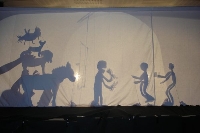 Als Schattentheater bezeichnet man neben dem Wayang und dem chinesischen Schattentheater die moderne Form des westlichen Schattenspiels, die in den 1980er Jahren entstand. (Quelle: wikipedia) Schattentheater ist eine sehr alte Kultur. Das Wayang-Puppentheater wurde sogar unter die Meisterwerke des mündlichen und immateriellen Erbes der Menschheit aufgenommen. [Bildquelle: Schattentheater Volksschule Hainfeld]
Als Schattentheater bezeichnet man neben dem Wayang und dem chinesischen Schattentheater die moderne Form des westlichen Schattenspiels, die in den 1980er Jahren entstand. (Quelle: wikipedia) Schattentheater ist eine sehr alte Kultur. Das Wayang-Puppentheater wurde sogar unter die Meisterwerke des mündlichen und immateriellen Erbes der Menschheit aufgenommen. [Bildquelle: Schattentheater Volksschule Hainfeld]
Die gezeigten Umrisse von Figuren, die durch eine Lichtquelle auf einer Leinwand sichtbar werden, sind aus der Sicht der Kommunikationstheorie vor allem eines: Eine massive Begrenzung der Information, die durch unseren Körper übermittelt wird. Der Körper, sonst das wichtigste Instrument des Menschen zu seiner Verständigung, wird reduziert auf einen Schatten. Einerseits findet eine Transformation vom 3D-Raum in den 2D-Raum statt, andererseits eine Ausblendung der Mimik und jeglicher Form von Kommunikation über z.B. das Aussehen via Kleidung. Einzig der Schatten als Abbild erscheint auf der Leinwand. Dem Schatten haftet etwas Unheimliches, Überwirkliches, Magisches, mit dem Verstand nicht Fassbares an. Kein Wunder, dass in den Volksmythologien vieler Kulturen der Schatten als Sitz der Seele und des Lebens beschrieben wird. Wer keinen Schatten hat, ist tot. (Quelle: Schattentheater) Was also kann es Lebendigeres geben, als einen Schatten?
Zwei Zitate von Roberto Casati, Autor des Buches „The Shadow Club“ (Quelle: Theater der Schatten):
„Die Form eines Schattens ist etwas Besonderes, weil sonst alles, was eine Form hat, materiell ist. Er ist reine Form.“
„Der Schatten ist vielleicht die einzige nicht abstrakte Erscheinung, die wahrhaft zweidimensional ist.“
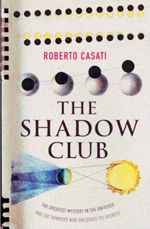 Das Wesentliche an dieser Form des Theaters ist aus meiner Sicht die Distanzinformation. Als einzige, wird sie unverfälscht – ja sogar einfacher ablesbar als vorher – auf der Leinwand sichtbar. Ich erkenne wie weit weg ein Darsteller von einem anderen Darsteller steht. Das bedeutet jedoch, dass aus kommunikationstheoretischer Sicht vor allem proxemische Information – also Information der Distanzveränderung – in den Mittelpunkt rückt, gemeinsam mit dem Audio (Stimmen, Geräusche, Musik), das meist dargeboten wird.
Das Wesentliche an dieser Form des Theaters ist aus meiner Sicht die Distanzinformation. Als einzige, wird sie unverfälscht – ja sogar einfacher ablesbar als vorher – auf der Leinwand sichtbar. Ich erkenne wie weit weg ein Darsteller von einem anderen Darsteller steht. Das bedeutet jedoch, dass aus kommunikationstheoretischer Sicht vor allem proxemische Information – also Information der Distanzveränderung – in den Mittelpunkt rückt, gemeinsam mit dem Audio (Stimmen, Geräusche, Musik), das meist dargeboten wird.
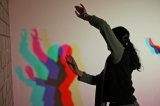 Update 10.6.2007
Update 10.6.2007
In einem Kulturangebot in der Schweiz habe ich eine Einrichtung entdeckt, die sich u.a. auch mit dem Schatten beschäftigt hat: Das Sensorium in Rüttihubelbad. Ganz nebenbei bin ich dabei auf das „No Science Festival EXPLORA“ gestoßen, deren Organisator offenbar die European Science Event Association ist. Ich wußte nichtmal dass es die überhaupt gibt. Interessant ist aber, was die machen:
The „Carousel of Science“ is the main project [..] It connects 31 European institutions in 29 cities of 24 countries/states with each other. These events are a collection of shows and presentations, where various aspects of science are shown to the general public. The presentations happen mostly outside of the usual science places: on the streets, in public places, in railway stations etc. Of course, sometimes the public is also invited into the laboratories of universities and other research institutions. But the main motto is: „Bringing Science to People“ – and not bringing people to science.
Das erinnert mich an das FameLab.
Why do i blog this? Das Schattentheater hat mich auf eine Idee gebracht, die ich in Kürze hier demonstrieren möchte. Dabei geht es um einen essenziellen Teil meiner Dissertation. Das Schattentheater ist hervorragend geeignet einige der Funktionsprinzipien einer im Rahmen meiner Dr.-Arbeit entstandenen Softwarekomponente zu erklären. Wie gesagt, in Kürze mehr dazu…
Übrigens: Weil ich selbst mittlerweile das „E-„ nicht mehr mag, habe ich mich in meinem Blog von allen „E-“ getrennt. Bei mir gibt es absofort nur noch „Learning“, „Mail“, „Assessment“ usw.

 Aber scheinbar haben die Macher von zweitgeist seit Lluna ein kleines Manko noch nicht beheben können, ich muss mir erst eine Zusatzsoftware dafür installieren.
Aber scheinbar haben die Macher von zweitgeist seit Lluna ein kleines Manko noch nicht beheben können, ich muss mir erst eine Zusatzsoftware dafür installieren. 
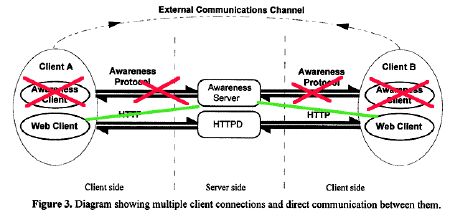
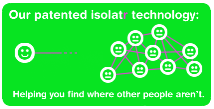 Das Logo jedenfalls ist schonmal gelungen, und die
Das Logo jedenfalls ist schonmal gelungen, und die  Und schon ist zweitgeist auch schon wieder Geschichte… denn jetzt heissen sie international überall aussprechbar
Und schon ist zweitgeist auch schon wieder Geschichte… denn jetzt heissen sie international überall aussprechbar  Die Zweitgeist GmbH setzt offenbar auf Partnerschaften, für die weitere Marktbearbeitung, neu im Angebot ist eine spezielle Softwareversion des Weblin-Client, der speziell auf den
Die Zweitgeist GmbH setzt offenbar auf Partnerschaften, für die weitere Marktbearbeitung, neu im Angebot ist eine spezielle Softwareversion des Weblin-Client, der speziell auf den  SecondLife itself is stirring up the blogosphere since LindenLab claimed to have passed the 1 Mio-Users-Milestone. Attention is also drawn to SL by the scientific community, e.g. from the
SecondLife itself is stirring up the blogosphere since LindenLab claimed to have passed the 1 Mio-Users-Milestone. Attention is also drawn to SL by the scientific community, e.g. from the